Heading out the door? Read this article on the new Outside+ app available now on iOS devices for members! Download the app.
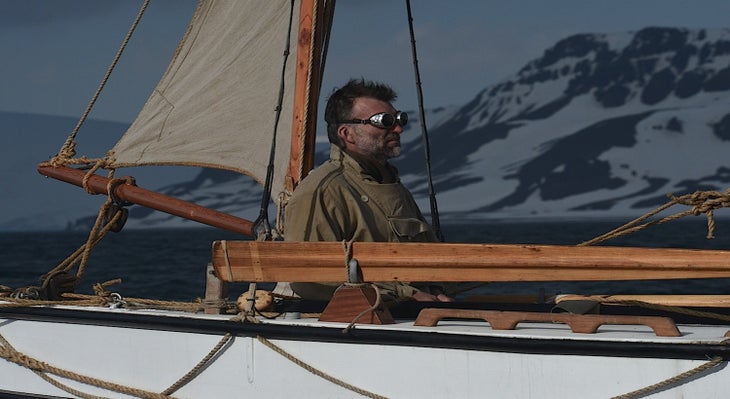
Tim Jarvis on the deck of the Alexandra Shackleton
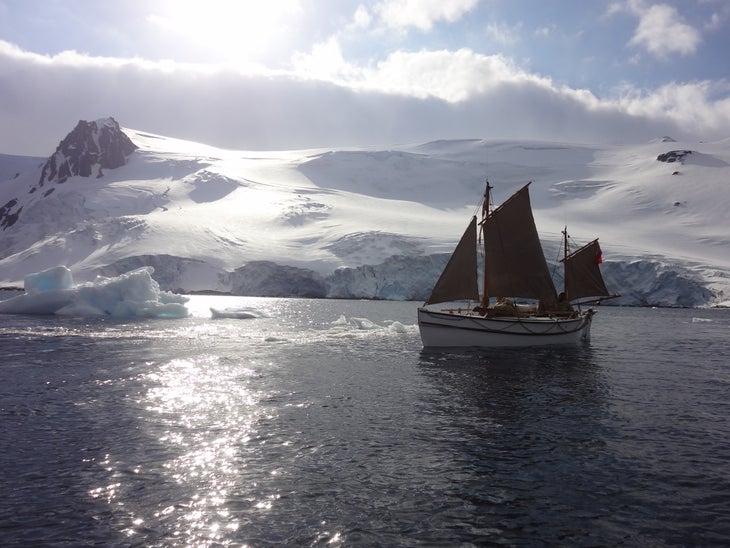
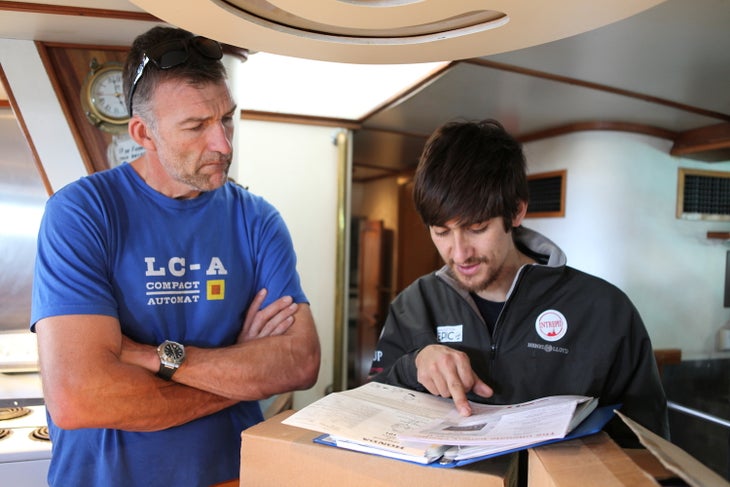
Expedition leader Tim Jarvis (left) and engineer Seb Coulthard plan logistics.
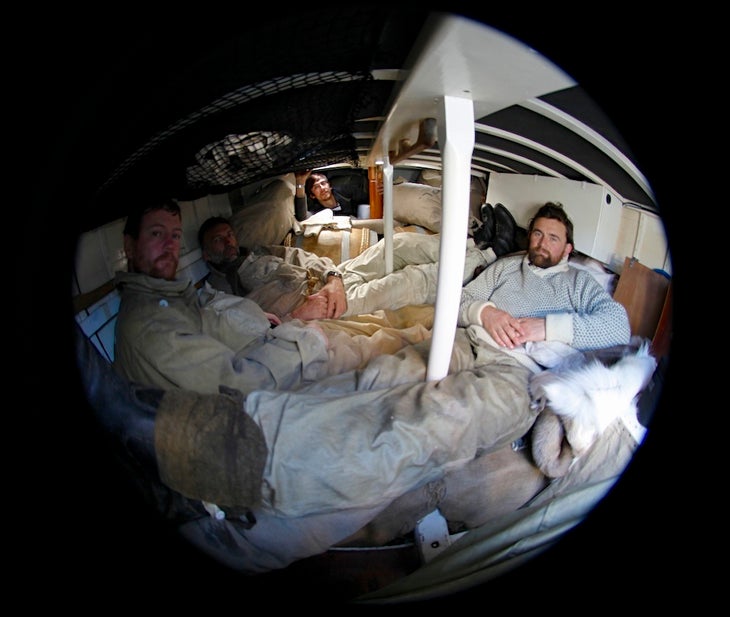
Conditions below deck on the Alexandra Shackleton were cramped.
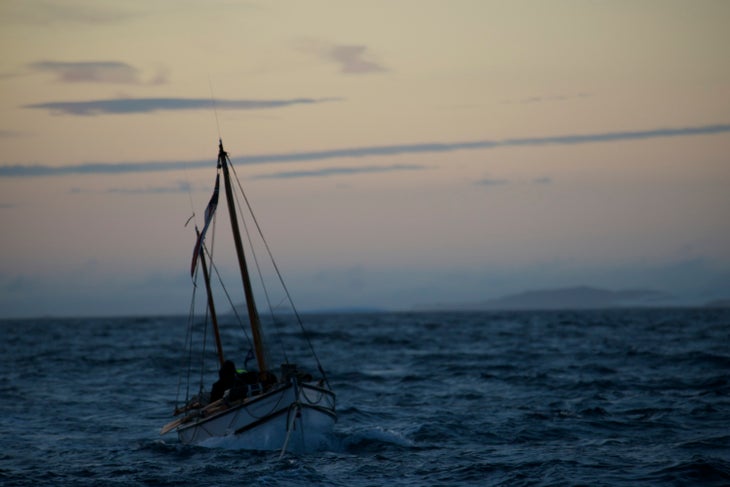
The Alexandra Shackleton braves the open seas.
Tim Jarvis is an internationally renowned environmental scientist and polar explorer who completed the fastest unsupported trek to the South Pole in 1999. In January 2013, he and a crew of five successfully re-created Sir Ernest Shackleton’s famous 1916 Antarctic survival journey by piloting a 22-foot wooden sailboat 800 nautical miles across the roughest seas in the world to South Georgia Island, followed up by a 32-mile overland trek across glaciated mountains—all without the aid of modern-day clothing or equipment. A 3-part documentary about the voyage, Chasing Shackleton, begins this week on PBS. In advance of the premiere, BACKPACKER reached Jarvis in London to discuss old school navigation, cold weather survival, and decisive action during a crisis.
Editor’s note: This transcript has been lightly edited for clarity and punctuation.
BACKPACKER: First off, congratulations on a tremendous accomplishment. Have you had sufficient time to process the scope of it now that some time has gone by?
TIM JARVIS: Thanks, yeah, it was a true team effort, the whole thing. When you achieve something as momentous as this, it takes a long, long time to really sink in. What I would say is that we haven’t done what Sir Ernest did, but we got as close as you can by getting in a boat and suffering in the old clothes and navigating and crossing South Georgia with no real equipment.
BP: Hopefully you’ve been on vacation someplace warm since then?
TJ: [chuckling] No, I haven’t, I haven’t had a chance to do that yet.
BP: How did Shackleton’s story influence you as you were growing up? Did it serve as a touchstone?
TJ: His story was all about achieving a goal against almost impossible odds. His being able to pull off what he managed to do set such a positive example that it couldn’t fail to have an impact on me, or anybody who might be attempting to overcome self-doubt. Anything is possible if you persevere, if you assemble the right team around you, and if you remain optimistic in the face of the conditions that you face. It’s always been out there for me as someone who has been interested in doing things to test himself, particularly in the polar regions. It’s just the biggest expedition that one could ever attempt.
BP: And you took after Shackleton himself in that you looked for very particular characteristics in the people who would accompany you.
TJ: Yes, I wanted people who took ownership of things. I didn’t want employees, I wanted people who were so keen to come that they were prepared to start managing aspects of the expedition almost before they’d been appointed in the role. I wanted to see how well they’d perform before I effectively gave the green light to actually have them on board. It takes a lot of confidence to do that: to work morning noon and night on an expedition you’re not sure you’ll be a part until I, as the expedition leader say, ‘look, I think you’ve proved your worth and can come.’
The people I got, their CVs and experiences were incredibly impressive. We had round-the-world sailors and mountaineers and survival experts. They were people who were prepared to work for nothing, as we all did, to participate. In everyday life, they wouldn’t be used to having to prove themselves, the CV would speak for itself. I suppose it was the other way around here. But I also wanted people who were team players, not people who brought big egos along with them and that’s difficult when you’re looking at people of such a high caliber. Paul Larsen, our navigator, is a 7-time world record holder and narrowly missed out on being made World’s Sailor this year at the Rolex Awards. Barry Gray is head of survival for the combined armed forces of the U.K. These people are really top performers, and yet they were prepared to be assessed by me for their adequacy for the role.
I also wanted people with a good sense of humor. That was extremely important. You need that when you’re six men sharing a space the size of a queen-size bed—except, of course, we were sleeping on rocks and camera batteries. So they needed to have a fairly unique set of characteristics, a lot of skill and humility and pragmatism and not too much ego. And I hit the right combination.
BP: Do those qualities lend themselves well to other survival situations, too?
TJ: I think that’s absolutely right. The key is to not take yourself too seriously. To elaborate on that, if you go to the Antarctic and you think that your CV or previous experience is going to stand you in better stead to make the journey, you’re very much mistaken. At the end of the day, the mountains or the oceans or particularly the ice caps down south are not at all interested in how honorable your cause is. You’re only going to be able to do this if you perform on the day. So that requires a certain humility. I approach every expedition as if it’s my first.
Of course, you bring with you a lot of skills and mind games you can bring to bear on situations you face, but at the end of the day, you’re only going to succeed if you can perform on the next expedition. You’re only as good as your next step. I think that not taking yourself too seriously is all part of having a good sense of humor about your chances. Self-delusion is a very useful skill to have. You’re always convincing yourself that things are better than they really are and that sort of carries you through.
BP: How did you design a training regimen to prepare the crew for the conditions they might face?
TJ: The key is expectation management. In the case of the three climbers, including myself, we had to prepare ourselves for the kinds of ocean conditions we might face. Huge seas in a small boat that. frankly, was not very seaworthy, with no keel. We went through the Royal Navy Lifeboat Institute sea survival training course and put ourselves through a whole other course on cold water immersion to see how long we could survive in old clothes in -2 degrees Celsius [28.4 degrees Fahrenheit] water.
And the sailors needed to be prepared for what they’d face on South Georgia, which is essentially an Antarctic weather system. You’re climbing at quite high altitudes up over heavily crevassed terrain and descending very steep passes. Baz [Gray] took the sailors out and put them through their paces in northern Scotland and it’s amazing to see people who are at the top of their game in their particular discipline put in a new environment like climbing. It’s interesting to see how they react and it teaches you a lot about those people.
When we got to Antarctica, we did more training for 10 days and some crevasse rescue training. The main emphasis was on training the sailors to be better climbers. But at the end of the day, the three climbers and three sailors in the boat had to be made to learn the other skill set as best they could in the time we had available.
BP: What was it like learning to use—and then relying upon—century-old equipment?
TJ: All of us are pretty good outdoors people, and we’re all familiar with compass/map work using modern equipment, but in the case of using a sextant, none of us with the exception of [expedition skipper] Nick Bubb and Paul Larsen had ever really used one in anger before. If you’re a sailor under the age of 45, you would probably have never learned to use one. We’ve had GPS for 20 years or so, so why bother learning to use a chronometer to navigate by? Four of us learned how to use the equipment to the extent that we needed to, whereas Nick and Paul became experts.
BP: Is there something to be said for not relying on modern technology?
TJ: That’s exactly right. I had a friend who died on the summit of Everest and he was on the satellite phone to his wife until the moment the batteries ran out. Just because you’re in contact doesn’t mean it’s going to get you anywhere. You can overestimate how safe you are. It was the same when I did a journey across Antarctica via the South Pole in 1999 in a bid to be the first person to go across completely unsupported. As I approached the pole from the Weddell Sea—effectively doing the route Sir Ernest Shackleton was trying to do when the Endurance was crushed—I found that my GPS didn’t work in the last 300 km [186 miles] approaching the pole because satellite coverage was too poor to get a signal. It wouldn’t give me a fix on where I was.
I had to use a compass and look at magnetic variation, the sastrugi under feet, and my body as a kind of sundial, knowing that at twelve noon at my particular latitude, the sun would be in the north and my shadow should theoretically be pointing south. I used that to double check my compass and my sastrugi bearings to navigate. So it’s very useful skill to be able to get yourself out of difficult situations without relying on technology.
BP: How did you keep tedium at bay and stay mentally focused?
TJ: That’s something I’ve become very adept at doing during treks on the polar plateau. It’s lot a like a frozen ocean, and you’re staring at an endless white horizon. When suffering, you need to still be able to zone out and think of things. I think the key is to impose your own structure on the world through which you’re traveling. You have 24 hours of light, no greenery, there’s no one there, and no support, so you have to impose your own mental framework on the environment. Lots of little things to think about, lots of positive mental images to keep yourself motivated. Mind games to push you, and positives to draw you onward. Work through math problems, redesign your house, think about friendships you’ve lost over the years and why that happened—whatever it takes.
In the boat, we were exchanging—where possible, anyway—tips on how to improve the running of the boat. That’s another thing, you know: just trying to stay mentally engaged all the time. And believe me, even in that environment where you think there would be boredom, you’re focused on constantly micro-managing your living space and things like that. Trying to keep equipment going, trying to keep your toes alive…you can find lots of things to occupy your time.
BP: Can you talk a bit about the camaraderie that developed during the journey?
TJ: Definitely, I think we’re all very close. Post-expedition, we all get on extremely well and I’m sure some of us will, when the opportunity arises, do things with one another again depending on the skill sets required. I personally don’t intend to get into a small boat again for a while, that’s one thing I’ve decided I don’t want to do. The next expedition might involve mountaineering, not sailing.
But no, we got on extremely well and there that bond, and we’re a year to date from when we set out from Ushuaia in South America to head south to King George Island. We’ve all kept in touch since that time and I’m sure we’ll continue to do so.
BP: Shackleton made the bold decision to strike out from the island when another expedition leader might have stayed put. What kinds of factors went into his thinking there?
TJ: I think he knew that no one would come. I think that the initial euphoria of getting off the pack ice, making it to Elephant Island and dry land, was immediately replaced by a realization that no one would find them. Elephant Island, to this day, doesn’t have any kind of human population. Even the whalers and the sealers back in those days were unable to establish a toehold there. It’s just too inhospitable. It’s either cliffs and vertical rocks or the snouts of glaciers. There’s no easy place to get a toehold with the exception of the two places he found, Cape Valentine and Point Wild. He knew no one would come.
So, in characteristic decisive fashion, he just basically decided he needed to keep the momentum of things going. He kept everyone motivated after the loss of Endurance by playing sport, caching additional food, and thinking very positively about their chance of success. It was all about keeping people engaged and busy so they didn’t have too much time to consider the dire straits that they were actually in. At the same time, we can all just sit here and wait, or someone can actually go and try to get a rescue. It was the only chance they had.
BP: And your expedition experienced a moment like that too, when you had to risk a narrow weather window in order to traverse the South Georgia mountains.
TJ: I think so, I think we were in exactly the same situation. We’d survived the small boat journey, we’d reached King Haakon Bay, there was obviously incredible euphoria about reaching that point. Then, suddenly, you’re now in a position of relative safety and you’re looking at the danger that was ahead: the crossing of the mountains. And subtly, your mindset changes from ‘if we can just make landfall on South Georgia, we can handle whatever the mountains throw at us, but just let us make it to the bay.’ Suddenly, that gets replaced by sitting in the bay looking at swirling mists and katabatic winds up on the heavily glaciated terrain and thinking “I’m not so sure I want to be up there.” You’re looking at danger from the position of safety.
There were injuries, obviously, that prevented a couple of the guys from going on, but then uncertainty started to set in. In those situations, the key thing is to make a proactive decision rather than sit there and allow morale to drop and for opinions to start becoming divided. In that case, it’s best to be decisive and go for it and that’s what we did.
BP: Any final thoughts on Sir Ernest Shackleton’s legacy?
TJ: We’ve only served to honor what he achieved. Some people ask me if, having done this journey effectively for a second time, you’ve proved that it’s something that mortal men can achieve, and although I’m very pleased with what we’ve done, I would never claim to have done all that he did. We didn’t lose the Endurance, we didn’t leave 22 men behind on Elephant Island, and at least people knew we were there. And of course, we didn’t have to survive on the shifting pack ice of the Weddell Sea before attempting the boat journey. All we’ve served to do is heighten the legend rather than diminish it. I hope that by doing what we’ve done, we bring this story to a whole new audience as we approach the 100th anniversary of the voyage.
Chasing Shackleton airs Wednesdays, January 8 – 22, on PBS at 10 PM EST. The companion book, Chasing Shackleton: Re-creating the World’s Greatest Journey of Survival, by Tim Jarvis, is available now (William Morrow; 2014).